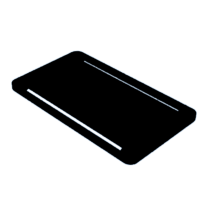Introduction: Rally Controller With Bluetooth
Do you want to try rally? Are the navigation equipment expensive? Look no further!
Here i will post how you make your own rally navigation controller for bikes.
There is 2 parts you need to make.
1. Handlebar controller
2. Bluetooth unit
This page will be updated with new designs, solutions and code so check in every now and then.
Step 1: Handelbar Controller Parts
Parts list:
3D printed shell.
Model v1.0 https://www.thingiverse.com/thing:4861162
Model v2.0 https://www.thingiverse.com/thing:4890343
Model buttons only https://www.thingiverse.com/thing:4890338
MCS18 Push Button IP65 round 18mm 48Vdc/125mA, part no: 1241.1104.7097
Gasket for MCS18 to IP65, part no: 0098.9201
Honeywell 1MT1-7 - Toggle switch (ON)-OFF-(ON) 1CO IP67/IP68, part no: 1MT1-7
RND Signal cabel 205-01148 - M8 connections, 2 m, 6 Pole, A-code, RND Connect, part no: RND 205-01148
M5 nuts
M5 bolts
O-ring outer diameter 13mm and rubber diameter 1,5mm
Tools:
Solder iron
Cutters
Small phillips screw driver
Super glue
Small wrench
Note: To make the unit cheaper you can change the RND Signal cabel and contact on the controller and Bluetooth unit, for a normal 6 pole wire, it will save you around 25-30€.
Step 2: Handelbar Controller Assemble
Print your shell.
I like to use PLA or PLA+ with a 50% infill and supports for the printing bed.
Clean the part from the support
Cut and glue 3mm (2,85mm) filament in to the shell as alignment pins.
Glue the M5 nuts in place.
Mount the MCS18 buttons with the gasket, and/or the toggle switch
Cut the 6 Pol signal cable to the length you want and thread it through the upper hole.
Run the GND (black cable) to all the buttons and or toggle switch and soder it in place.
The cabels have these functions:
Black - GND
Brown - Tripp down
Pink - Tripp up
Grey - Roadbook FW
White - Roadbook - BW
Blue - Play/Paus
Soder the cabel to the switch function you want to have, most Roadbook apps have the function to change the buttons.
Glue the shell parts together use rubber bands and or spring clamps to make a tight fit.
If you have gaps use more super glue or plastic putty to seal the model.
Step 3: Bluetooth Units
Here you have two options, one with a premade Bluetooth sender and a one ESP32 you program yourself.
Premade Bluetooth puck.
Pros:
No programming
Battery powered
Easy to change battery
Small
Cons:
Hard to soder
Might need to edit the 3D model
ESP32
Pros:
Easy to soder
Can be USB and battery powerd
Can update the software
Cons:
Needs to be program
Gets big with a battery
Needs expensive special battery
Step 4: Premade Bluetooth Unit
Parts:
3D printed case https://www.thingiverse.com/thing:4890354
Bluetooth unit.
Sensor cabel, 6 Pole, M8, RND Connect part number: RND 205-01122.
Rubber O-ring 45 mm outer diameter and 3.3 mm diameter on the rubber.
M5 nuts
M5 screws 22 mm
Tools:
Solder iron
Cutters
Small phillips screwdriver
Small wrench
Superglue
5mm drill
Connect the unit to your device.
Print the case, check if the mounting hole is the right size.
Different brand have slightly different sizes +- 1 mm
If not, edit the model and reprint.
Drill out the holes with a 5mm drill.
Glue the M5 nuts in place.
Mount the sensor cabel in the 3D printed case.
Push the nut from the sensor cable in the groves in the case and screw the cable in place.
Be carefully when sobering, the board its sensitive to overheating and will destroy the unit.
Open the unit and remove the button front to expose the board and reinstall the case.
Soder:
Black to any -
Brown to V- +
Pink to V+ +
Grey to NEXT +
White to PRVE +
Blue to PLAY +
Push in to place and install the rubber O-ring.
Screw the lid in place and you're done.
Step 5: ESP32 With USB Power
Parts:
3D printed case https://www.thingiverse.com/thing:4890356
ESP32.
Sensor cabel, 6 Pole, M8, RND Connect part number: RND 205-01122.
M4 15 mm screws
Micro USB cabel
Tools:
Solder iron
Cutters
Small wrench
Superglue
4mm drill
Connect the ESP32 to the computer and follow the IDE guide.
Then install the following packets to the library in the Arduino app.
BleKeyboard.h https://github.com/T-vK/ESP32-BLE-Keyboard
Bounce2.h https://github.com/thomasfredericks/Bounce2
Follow the guide to install the code to the ESP32.
Drill out the holes in the cover with a 4mm drill.
Dry fit the ESP32 in the case with the USB cable. the case if for a xxxmm micro USB with a 3mm diameter cable.
If the cable is bigger drill out the hole to fit, you might need to remove some rubber from the micro USB to make it fit.
Mount the sensor cable in the hole and cut the cables to length.
Soder the after the ESP32 pinout picture.
Connect the micro USB and screw the case together, if you want the case watertight use superglue and use spring clamps to make a tight seal.
Prime and paint if you want, and your done!
Step 6: ESP32 With Battery
Parts:
3D printed case https://www.thingiverse.com/thing:4861175
ESP32.
Sensor cabel, 6 Pole, M8, RND Connect part number: RND 205-01122.
M4 15 mm screws
Singel or dubbel AA battery holder
26650 Li-ion-batteri 3,6 V (AA size)
On - Off toggle, mounting hole 6x11mm
Tools:
Solder iron
Cutters
Small wrench
Superglue
Connect the ESP32 to the computer and follow the IDE guide.
Then install the following packets to the library in the Arduino app.
BleKeyboard.h https://github.com/T-vK/ESP32-BLE-Keyboard
Bounce2.h https://github.com/T-vK/ESP32-BLE-Keyboard
Follow the guide to install the code to the ESP32.
Here you can find the code. https://github.com/T-vK/ESP32-BLE-Keyboard
A new code will come!
If you use a dubbel AA battery holder solder a cable from one of the battery spaces + to -
Test and dryfit all the components in the 3D printed case.
Solder the battery holder+ to the On - Off toggle and then to the ESP32 3.3V pin.
Then the - from the holder to GND on the ESP32.
Soder the signal cable after the ESP32 pinout picture.
Glue the On - Off toggle in place.
Note thet depending on your battery, you might need to put some extra solder on the + side of the battery holder to get a proper connection.
Riding hard enduro might get the battery to compress the spring so you lose power for a fraction of a second, you can mediate that by stiffening the spring with for an example small washers.
Do you want the box watertight? Put it in a plastic bag and zip tie the end.












